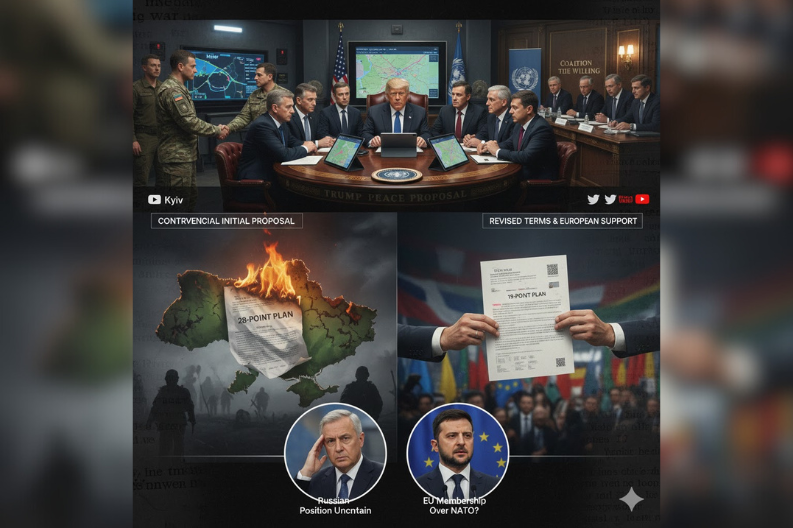Intense diplomatic efforts to end the Ukraine war accelerated this week as President Donald Trump revealed plans for high-level meetings with both Russian and Ukrainian leaders. Moreover, Trump announced that special envoy Steve Witkoff will travel to Moscow next week, possibly accompanied by his son-in-law Jared Kushner. Meanwhile, Army Secretary Dan Driscoll will meet Ukrainian officials in Kyiv later this week.
Trump stated that significant progress has occurred on drafting a peace proposal. However, at least three crucial sticking points remain unresolved, according to Ukrainian sources. Additionally, the president walked back his earlier Thursday deadline for Ukraine to accept the plan, saying instead, “You know what the deadline for me is? When it’s over.”
The negotiations center partly on territorial issues. Trump explained that working out border details proves complicated because “you can’t go through the middle of a house” or “through the middle of a highway.” Nevertheless, he noted that Russia has made some initial concessions, primarily agreeing to stop fighting and halt further territorial advances.
Ukrainian Response to Peace Terms: Ukraine’s lead negotiator, Rustem Umerov, expressed cautious optimism. He wrote on social media that delegations reached “a common understanding on the core terms of the agreement discussed in Geneva.” Furthermore, Ukraine’s Presidential Office Chief of Staff Andriy Yermak confirmed that Driscoll’s visit would continue peace talks.
Ukraine says it has reached a “common understanding on the core terms of the agreement” with the United States after the Geneva talks.
The most sensitive issues are left open pending a face-to-face meeting between Zelenskyy and Trump. https://t.co/stMQqTtVwl
— Jorge Liboreiro (@JorgeLiboreiro) November 25, 2025
White House press secretary Karoline Leavitt similarly noted there are “a few delicate, but not insurmountable, details that must be sorted out.” This suggests both sides believe a deal remains achievable despite remaining differences.
The Controversial Initial Proposal
The leaked 28-point draft plan sparked significant controversy last week. Critics, including Ukrainian officials and European allies, viewed it as capitulation to Moscow. The proposal required Ukraine to abandon NATO membership aspirations, cede territory, and scale back its military capabilities.
During his Kyiv visit last week, Driscoll delivered a grim battlefield assessment to Ukrainian officials. According to sources, he warned that Ukrainian troops faced imminent defeat against Russian forces. Additionally, he stated that Russia could fight indefinitely while Ukraine’s position would only weaken over time.
Driscoll also conveyed disappointing news about American military support. The US defense industry cannot continue supplying weapons and air defenses at the rate needed to protect Ukraine’s infrastructure and population, he explained. Consequently, his message essentially urged Ukraine to accept the deal rather than face worse terms later.
Internal US Administration Split: The peace negotiations have exposed a significant rift within Trump’s administration. One faction, including Vice President JD Vance and Witkoff, views Ukraine as the primary obstacle to peace. Therefore, they favor using American leverage to force Kyiv into major compromises.
Conversely, Secretary of State Marco Rubio leads another camp that blames Russia for launching an unprovoked invasion. This group argues Moscow will only relent if it pays a price through sanctions and other pressure. Rubio flew to Geneva over the weekend and, after consulting European diplomats, helped remove the most problematic provisions from the original plan.
Revised Terms and European Support: Following weekend talks, the plan evolved from 28 points to 19 points. The revised version addresses many Ukrainian and European concerns. Leaders from the Coalition of the Willing, including UK, France, and Germany, expressed support for Trump’s peace efforts while stressing that borders “must not be changed by force.”
They emphasized that any solution must fully involve Ukraine, preserve its sovereignty, and align with UN Charter principles. Additionally, they agreed that peace requires “robust and credible security guarantees for Ukraine.”
Russian Position Remains Uncertain: Despite initial progress, Russian Foreign Minister Sergey Lavrov suggested Moscow might reject the amended plan. He indicated Russia could refuse if terms differ “fundamentally” from understandings reached during earlier Trump-Putin discussions. Furthermore, Kremlin adviser Yuri Ushakov criticized the leak of a call between him and Witkoff, suggesting it was intended to interfere with building Moscow-Washington relations.
Former NATO Supreme Allied Commander James Stavridis offered a perspective on Ukraine’s future security. He suggested President Volodymyr Zelensky should prioritize European Union membership over NATO for now. “What I would focus on if I were Team Zelensky is getting into the European Union. NATO will come along sooner rather than later,” Stavridis stated.
However, he acknowledged that territorial concessions represent an imperfect outcome. Nevertheless, he argued such a solution remains “better than Putin running the table and conquering Ukraine.”
The coming weeks will prove critical for the Ukraine war peace process. Trump hopes to meet both Putin and Zelensky once the proposal reaches final stages. Meanwhile, diplomatic teams continue working to resolve remaining disagreements on territory, security guarantees, and Ukraine’s future international alignment. Despite internal American divisions and Russian skepticism, negotiators on multiple sides maintain that ending Europe’s largest conflict since World War II remains achievable through continued dialogue and compromise.



